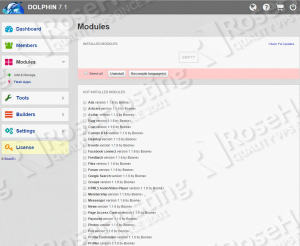
Boonex Dolphin is a popular social networking platform used by many webmasters. It allows them to build easy to use community and social media oriented websites.
This install guide assumes that Apache, MySQL, PHP and a fully functional mail server are already installed and configured on your server. At the time of this writing, the latest version of Dolphin is 7.1.6 and it requires:
- PHP >= 5.3.0 (PHP 5.5 or later is recommended) with the following PHP extensions enabled: curl, fileinfo, ftp, GD Graphics Library version 2.0.x+ compiled with FreeType fonts (or ImageMagick), JSON, mbstring, mysql, openssl, xsl and zip.
- Apache Web Server >= 2.0 compiled with mod_rewrite module
- A mail server for sending emails (Sendmail, Postfix etc.)
- MySQL >= 4.1.2 installed on your Linux virtual server (MySQL 5.5 or later is recommended)
- Java 1.6 or higher (some of Dolphin’s features require media streaming capabilities)
- Ability to create cron-jobs and execute files.
Download the latest version of Dolphin available at ‘http://www.boonex.com/downloads?product=Dolphin-v.7.1’ to the server and extract it using the following commands:
cd /opt wget http://get.boonex.com/Dolphin-v.7.1 -O dolphin-v.7.1.6.zip unzip dolphin-v.7.1.6.zip
Move the unpacked Dolphin files to the document root of your website:
mv Dolphin-v.7.1.6 /var/www/html/dolphin
Set the proper file permissions for the Apache web server to write to certain files and directories:
chown www-data:www-data -R /var/www/html/dolphin
Also, run the following command to make the ‘ffmpeg.exe’ file executable:
chmod 755 /var/www/html/dolphin/flash/modules/global/app/ffmpeg.exe
Install Java and ImageMagick:
apt-get install openjdk-7-jdk apt-get install ImageMagick
Create a new database for Dolphin and assign a MySQL user with privileges for accessing and modifying the Dolphin database:
mysql -u root -p mysql> CREATE DATABASE dolphindb; mysql> GRANT ALL PRIVILEGES ON dolphindb.* TO 'dolphinuser'@'localhost' IDENTIFIED BY 'your-password' WITH GRANT OPTION; mysql> FLUSH PRIVILEGES; mysql> quit
Create a new virtual host directive in Apache. For example, create a new Apache configuration file named ‘dolphin.conf’ on your virtual server:
touch /etc/apache2/sites-available/dolphin.conf ln -s /etc/apache2/sites-available/dolphin.conf /etc/apache2/sites-enabled/dolphin.conf vi /etc/apache2/sites-available/dolphin.conf
then, add the following lines to it:
<VirtualHost *:80> ServerAdmin admin@yourdomain.com DocumentRoot /var/www/html/dolphin/ ServerName your-domain.com ServerAlias www.your-domain.com <Directory /var/www/html/dolphin/> Options FollowSymLinks AllowOverride All </Directory> ErrorLog /var/log/apache2/your-domain.com-error_log CustomLog /var/log/apache2/your-domain.com-access_log common </VirtualHost>
Edit the php.ini configuration file and add/modify the following lines:
vi /etc/php5/apache2/php.ini
memory_limit = 128M file_uploads = On allow_url_fopen = On allow_url_include = Off register_globals = Off safe_mode = Off short_open_tag = On magic_quotes_gpc = Off default_charset = "UTF-8"
Make sure that ‘exec’ PHP function is allowed (i.e. it is not listed in disable_functions) and ‘open_basedir’ is not set:
#php -i | grep -i disable_functions disable_functions => no value => no value #php -i | grep -i open_basedir open_basedir => no value => no value
Restart the Apache web server for the changes to take effect:
service apache2 restart
Open http://your-domain.com/install/index.php in your favorite web browser and follow the easy instructions: Check if the file and directory permissions are set correctly, check the paths to website’s document root and scripts, enter 3306 as database host port number, then enter database name, database user and password, enter site title, site description and create a new administrator user.
To keep your website secure, remove the write flag from the ‘inc’ directory:
chmod -w /var/www/html/dolphin/inc/
Set a new cron job. For example, run the following command:
crontab -e
and add the following lines:
MAILTO=admin@emailaddress.com * * * * * cd /var/www/html/dolphin/periodic; /usr/bin/php -q cron.php
Do not forget to change ‘admin@emailaddress.com’ with your actual email address, then run:
service cron restart
After finishing the installation, it is recommended to delete all files and subdirectories from the install directory located to your Dolphin website document root as a security precaution, so run the following command:
rm -rf /var/www/html/dolphin/install/
That is it. The Dolphin installation is now complete. Proceed to the admin panel to configure Dolphin according to your needs, install additional modules etc.
Of course you don’t have to do any of this if you use one of our Linux VPS Hosting services, in which case you can simply ask our expert Linux admins to install Boonex Dolphin for you. They are available 24×7 and will take care of your request immediately.
PS. If you liked this post please share it with your friends on the social networks using the buttons on the left or simply leave a reply below. Thanks.
